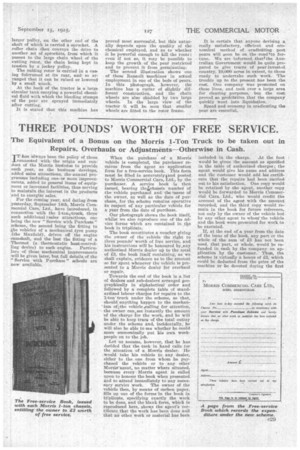FIGHTING ONE OF AUSTRALIA'S PESTS.
Page 12

Page 13

If you've noticed an error in this article please click here to report it so we can fix it.
Some of the Means which have been Employed, and a Brief Description of a Renault Chain-track Tractor Equipped for the Purpose.
IXTHILST Australia is, from many 1'V points of view, an ideal country for the settler, and presents unbounded possibilities ,taf [fortune to those of energy and initiative, yet in certain parts of the continent there are several drawbacks which the Ooraraonwealth Government is doing all in its Power to combat. The scarcity of water in the interior is too well known to require comment, but, curiously enough, the two other most important drawbacks to progress, apart from this, are of foreign importation, one being the rabbit and the other the prickly pear— a plant of cactus-like nature—both being brought over by well-meaning but misguided individuals.
The prickly pear is in two main varieties, the edible type, which is of comparatively small growth, and what is known as the pest pear. This was brought over from South America by a farmer who thought it would make a nice hedge round his homestead. After planting it, he found that his stock appeared to like the fruit, so he planted other patches, and some other farmers followed his example, but, once planted, the pest pear began to take possession and, as a result, it now covers some 20,000,000 acres of ground in Queensland, and 2,000,000 in New South Wales and, what is more important, is spreading at the rate of 1,000,000 acres per year, and this growth is something in the nature of compound interest, for the bigger the area the greater the speed of spread.
In order to allay any fears regarding the suitability of Australia for emigrants we hasten to add, however, that the prickly pear is not causing any trouble in agricultural areas, but is essentially a product of the grazing land. As a matter of fact, it is not altogether a disadvantage because camels, which are utilized in certain parts of the Australian continent, and stock feed on it fairly freely, but it does not do them much good. Endeavours are now being made to cut it down for the making of commercial aloohol, but, so far, this work has not been carried to any great length.
In some parts the pest pear grows to a height of 10 ft., and is so thick that horses cannot penetrate it ; the general average, however, is from 3 ft. to 5 ft.
The total area when compared with that of Queensland does not seem very formidable, as Queensland comprises 670,500 square miles, but it is GO pertinacious that after being cut down the roots dug up and injections made -in the soil, it still sprouts.
Amongst the efforts made to prevent its growth, the Government has imported cochineal insects which, in South America, proved effective, as they ate the pest as a whole, but when the same insects were bred in Australia they confined their efforts solely to the edible fruit and, consequently, were useless for the purpose. Other insects are now being experimented with and—it is believed—with rather more success. The danger which always has to be faced is that the "cure ".. may flourish so exceedingly in the wonderful Australian air as to become a peet in itself.
Use is also being made by farmers and others of mechanical appliances, usually combined with the employment of chemical liquids. In this connection we publish two illustrations, one showing a.Renanit chain-track tractor of the type with which many of our readers are familiar, but equipped with a rotary framework at the front end, which carries spirals on which are mounted strong cutters. The drive to these is taken first through a pulley at the off side of the machine close to the driver's seat, then forward by a flat belt to a
larger pulley, on the other end of the shaft of which is carried a sprocket. A roller chain then conveys the drive to another set of sprockets, from which it passes to the large chain wheel of the cutting rotor, the chain being kept in tension by a jockey pulley.
The cutting rotor is carried in a casing fulcrumed at its rear, and so arranged that it can be raised or lowered by a small winch.
At the back of the tractor is a large circular tank carrying a powerful chemical fluid with which the bleeding stumps of the pear are sprayed immediately after cutting.
It is stated that this machine has
proved most successful, but this naturally depends. upon the quality of the chemical employed, and as to whether it be powerful enough to kill the roots ; even if not ISO, it may be possible to keep the growth of the pear restricted and to prevent it from germinating.
The second illustration shows one of • these Renault machines in actual employment in one of the beds of pears. In this photograph, however, the machine has a cutter of slightly different construction, and the chain wheels are also shielded by two large wheels. In the lunge view of the tractor it will be seen that smaller wheels are fitted to the rotor frame. . It is certain that anyone devising a really satisfactory, efficient and economical method of eradicating post pears will soon be on the road to fortune. We are informed thee the Australian Government would be quite prepared to give tracts of pear invested country, 10,000 acres in extent, to those ready to undertake such work. The trouble up to the present has been the cost. One company was promoted on these lines, and took over a large area for clearing purposes, but the cost proved so prohibitive that the company quickly went into Speed and economy in eradicating the pear are essential.






























